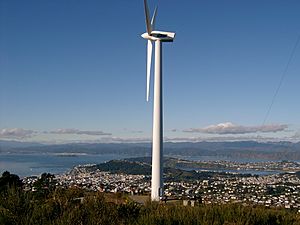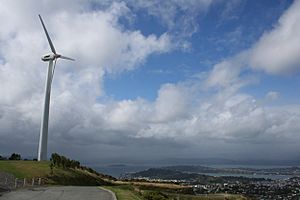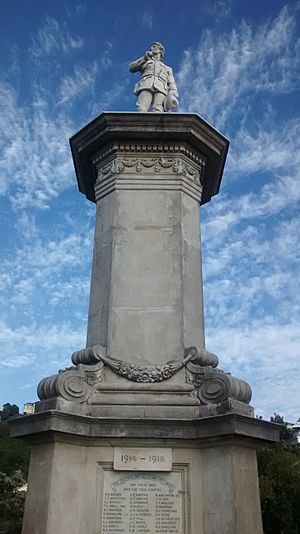Brooklyn, Wellington facts for kids
Quick facts for kids
Brooklyn
|
|
|---|---|
|
Suburb
|
|
 |
|
| Country | New Zealand |
| Local authority | Wellington City |
| Electoral ward | Paekawakawa/Southern Ward |
| Established | 1888 |
| Area | |
| • Land | 398 ha (983 acre) |
| Population
(June 2022)
|
|
| • Total | 6,800 |
| Postcode(s) |
6021
|
| Aro Valley | Mount Cook | |
| Karori |
|
Vogeltown |
| Ōwhiro Bay | Mornington, Kingston |
Brooklyn is a suburb of Wellington, the capital city of New Zealand. It is a lively community known for its parks, a famous wind turbine, and interesting history.
Exploring Brooklyn's Geography
Where is Brooklyn Located?
Brooklyn is about 3 kilometers south of Wellington's main city area. It sits on the eastern side of hills above Happy Valley.
Here are some nearby places:
- To the north: Aro Valley and Highbury
- To the east: Mount Cook
- To the south: Vogeltown, Mornington and Ōwhiro Bay
- To the west: Kowhai Park, Panorama Heights, Mitchelltown, Karori
Parks and Green Spaces
Central Park
Central Park separates Brooklyn from the city. It was created in 1913 on Town Belt land. The park has beautiful wrought-iron gates at its main entrance. These gates were given by the Mayor of Wellington, John Pearce Luke, in 1920.
During World War II, American forces set up a military camp here. This camp was used by the United States Marine Corps from 1942 to 1944.
Tanera Park
Tanera Park is north of Central Park, across Ohiro Road. This park has great sports facilities. You can find fields for soccer and cricket here. There are also artificial surfaces and changing rooms.
In 1991, part of the park became a special garden. This garden helps families and groups grow their own vegetables. These are now known as the Tanera Community Gardens.
Elliott Park
Elliott Park is on the western side of Brooklyn. It is next to Mitchell Street and Karepa Street. This park used to have a children's playground. However, the playground was removed by the Wellington City Council.
Brooklyn Hill
Brooklyn Hill is a high point in the area. It stands about 299 meters (981 feet) tall.
The Brooklyn Wind Turbine

The Brooklyn wind turbine is a famous landmark. It was put on Pol Hill in March 1993. This was part of a project to study wind power. Wellington was chosen because it has very strong winds. The turbine can be seen from many parts of the city. It is 299 meters above sea level.
The first turbine was replaced in 2016 with a bigger one. The new turbine is a German Enercon E-44. It can produce 900 kW of power. This is enough electricity for about 490 homes. The power goes into the local network for everyone to use. The tower is 44 meters high, and its blades are 20.8 meters long.
Meridian Energy has managed the turbine since 1999.
Brooklyn War Memorial
Brooklyn has a World War I war memorial. It is on top of Sugarloaf Hill. The memorial lists the names of 48 Brooklyn soldiers. These soldiers died in the war.
People started raising money for the memorial in 1918. It was unveiled on September 22, 1922. The memorial is a carved marble statue of a soldier. It looks towards the harbor, where troopships sailed from.
The Wellington City Council now takes care of the memorial. It was restored in 2003. The words on the memorial say: The motherland called and they went and these men died for their country.
Pol Hill Gun Emplacements
On Pol Hill, you can find old anti-aircraft gun emplacements. These were built in March 1942. They were made to defend Wellington during World War II. This was because people worried about Japanese air raids. The battery could house 109 army personnel.
These old military sites are near the wind turbine. They are also close to the Zealandia wildlife sanctuary.
Brooklyn's Buildings and Homes
Architectural Styles
Brooklyn has many different styles of buildings. Some of the oldest homes are simple villas from around 1895. These often had a hallway with rooms on each side. They also had an indoor bathroom and a "lean-to" for storage. Many homes used a "back-to-back" chimney design. This meant one chimney could serve fireplaces in both the living room and kitchen.
Other styles you can see include:
- Bay villas: from around 1910
- California bungalows: from around 1920
- State Houses: built between 1930 and 1940
- Modern bungalows: from around 1960
Special Buildings
- The Sutch House: This house on Todman Street was designed by Ernst Plischke. It was built between 1953 and 1956. The house has a modern design. It has won an award for its lasting architecture.
- Tower Studio: Located on Karepa Street, this building looks like a Tuscan tower. It has five levels and offers amazing 360-degree views. It overlooks the native bush in Brooklyn.
Brooklyn's History
Early Māori History
Before Europeans arrived, Māori people knew the Brooklyn hills as Turanga-rere. This name means "the waving plumes of a war-party." It might describe how the trees on the hills waved in the wind.
Many Māori iwi (tribes) lived in the Wellington area. These include Te Āti Awa, Muaupoko, Rangitāne o Wairarapa, Ngāti Raukawa, Ngāti Toa, and Te Atiawa ki Whakarongotai.
European Settlement
European settlers started arriving in the 1840s. In 1842, the ship London arrived in Wellington. It carried many families, including John and Louisa Fitchett and their seven children.
The area was first called Ohiro. In 1852, John Fitchett bought land and started Ohiro Farm. A small town called Fitchett Town grew in the 1860s. In 1888, the land owners renamed it "Brooklyn." This was when they offered many land lots for sale.
Later, more streets were added, like Mitchell and Todman Streets. In 1902, Brooklyn grew even more up the hills.
A new tramway opened in 1906. This made it easier to travel to Brooklyn. The tramway closed in 1957. Today, buses serve the route.
Brooklyn gets its name from a borough in New York City. That name comes from the Dutch city Breukelen. Many streets in Brooklyn are named after former US Presidents:
- Cleveland Street (after Grover Cleveland)
- Coolidge Street (after Calvin Coolidge)
- Garfield Street (after James Garfield)
- Harrison Street (after William Henry Harrison)
- Hoover Street (after Herbert Hoover)
- Jefferson Street (after Thomas Jefferson)
- Lincoln Street (after Abraham Lincoln)
- McKinley Crescent (after William McKinley)
- Taft Street (after William Taft)
- Washington Avenue (after George Washington)
Brooklyn's Community and Facilities
Population and People
Brooklyn is home to many people. In 2018, its population was about 6,708. Most people in Brooklyn are of European descent. There are also Māori, Pacific peoples, and Asian communities. Many people living here were born overseas.
Local Cinema
Brooklyn has its own movie theater, the Penthouse Cinema. It is on Ohiro Road. It first opened on June 15, 1939, as the Vogue Theatre. It was built in the Art Deco style. Later, it became a TV studio. In 1975, it was bought and renamed the Penthouse Cinema. It has been updated but still keeps its original style.
Brooklyn Library
Brooklyn has a branch library. It opened on February 16, 1905. It was the second branch of the main Central Library. The library moved to its current building in 1960. You can find it on the corner of Harrison and Cleveland Streets.
Churches in Brooklyn
- Wellington Korean Church: 184 Ohiro Road
- Reformed Church of Wellington: 36 Harrison Street
- Anglican/Two Todman: 2 Todman Street. This place has a co-working office, community space, chapel, and an op-shop.
Transport Around Brooklyn
Brooklyn is served by bus routes 7, 17, and 29. These buses help people travel around the suburb and to other parts of Wellington.
Malaysian High Commission
The Malaysian High Commission is located in Brooklyn. It is on the corner of Washington Avenue and Brooklyn Road. This is the world's southernmost High Commission.
Education in Brooklyn
Brooklyn School
Brooklyn School is a state school for children from Year 1 to Year 8 (ages 6 to 12). It is a co-educational school, meaning both boys and girls attend. The school first opened in November 1888.
St Bernard's School
St Bernard's School is a Catholic primary school. It is for students from Year 1 to Year 8. The school started in 1935. It was first called St Anthony's School Brooklyn. It was located in the church on Jefferson Street.
In 1949, a new school was built on Taft Street. In 1961, the school changed its name to St Bernard's. The Sisters of Mercy ran the school until 1973.
Brooklyn Early Childhood Centre
The Brooklyn Early Childhood Centre (BECC) is a community creche. It opened in 1993. It is a not-for-profit center for young children.
Famous People from Brooklyn
Many interesting people have connections to Brooklyn:
- Ernst Plischke (1903–1992): A famous architect.
- Jane Thomson (1858–1944): A mountaineer.
- Shihad: A well-known band.
- Bill Sutch (1907–1975): A teacher, economist, writer, and diplomat.
- Raymond Ching (1939-): A painter.


